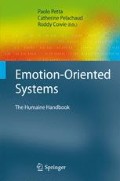Abstract
The HUMAINE Database is grounded in HUMAINE’s core emphasis on considering emotion in a broad sense – ‘pervasive emotion’ – and engaging with the way it colours action and interaction. The aim of the database is to provide a resource to which the community can go to see and hear the forms that emotion takes in everyday action and interaction, and to look at the tools that might be relevant to describing it. Earlier chapters in this handbook describe the techniques and models underpinning the collection and labelling of such data. This chapter focuses on conveying the range of forms that emotion takes in the database, the ways that they can be labelled and the issues that the data raises. The HUMAINE Database provides naturalistic clips which record that kind of material, in multiple modalities, and labelling techniques that are suited to describing it. It was clear when the HUMAINE project began that work on databases should form part of it. However there were very different directions that the work might have taken. They were encapsulated early on in the contrast between ‘supportive’ and ‘provocative’ approaches, introduced in an earlier chapter in this handbook. The supportive option was to assemble a body of data whose size and structure allowed it to be used directly to build systems for recognition and/or synthesis. The provocative option was to assemble a body of data that encapsulated the challenges that the field faces.
Access this chapter
Tax calculation will be finalised at checkout
Purchases are for personal use only
References
Bänziger T, Scherer K (2007) Using actor portrayal to systematically study multimodal emotional expression: the GEMEP corpus. In: Paiva A, Prada R, Picard R (eds) Affective computing and intelligent interaction, Lisbon, Sept 2007. Springer LNCS , Berlin, pp 476–487
Cowie R, Douglas-Cowie E, Tsapatsoulis N, Votsis G, Kollias S, Fellenz W, Taylor J (2001) Emotion recognition in human-computer interaction. IEEE Signal Process Mag 32–80, January 2001
Devillers L, Cowie R, Martin J-C, Douglas-Cowie E, Abrilian S, McRorie M (2006) Real-life emotions in French and English TV video corpus clips: an integrated annotation protocol combining continuous and discrete approaches. In: LREC 2006, Genoa. http://www.cs.brandeis.edu~marc/misc/proceedings/lrec-2006/workshops/W09/Emotion-proceeding.pdf
Douglas-Cowie E, Campbell N, Cowie R, Roach P (2003) Emotional speech: towards a new generation of databases. Speech Commun 40(1–2):33–60
Douglas-Cowie E, Cowie R, Sneddon I, Cox C, Lowry O, McRorie M, Martin J-C, Devillers L, Abrilian S, Batliner A, Amir N, Karpouzis K (2007) The HUMAINE database: addressing the collection and annotation of naturalistic and induced emotional data. In: Paiva A, Prada R Picard R (eds) Affective computing and intelligent interaction, Lisbon, Sept 2007. Springer LNCS, Berlin, pp 488–500
Douglas-Cowie E, Devillers L, Martin J-C, Cowie R, Savvidou S, Abrilian S, Cox C (2005) Multimodal databases of everyday emotion: facing up to complexity. In: 9th European conference on speech communication and technology (Interspeech’ 2005), Lisbon, Portugal, 4–8 Sept 2005, pp 813–816
Hönig F (2007) DRIVAWORK – driving under varying workload. A multi-modal stress database in the automotive context. Vortrag: HUMAINE plenary meeting, Paris, 6 Jun 2007
Ioannou S, Raouzaiou A, Tzouvaras V, Mailis T, Karpouzis K, Kollias S (2005) Emotion recognition through facial expression analysis based on a neurofuzzy network. Neural Netw (Elsevier) 18:423–435
Scherer KR, Ellgring H (2007) Are facial expressions of emotion produced by categorical affect programs or dynamically driven by appraisal? Emotion 7(1):113–130
Sneddon I, McRorie M (2006) Perception of emotional expression. In: Poster presented at the 13th European conference on personality, Athens
Zara A, Maffiolo V, Martin J-C, Devillers L (2007) Collection and annotation of a corpus of human–human multimodal interactions: emotion and other anthropomorphic characteristics. In: Paiva A, Prada R, Picard R (eds) Affective computing and intelligent interaction, Lisbon, Sept 2007. Springer LNCS , Berlin, pp 464–475
Author information
Authors and Affiliations
Corresponding author
Editor information
Editors and Affiliations
1 Appendix 1: User Agreement – HUMAINE Database
This user agreement applies to the database HUMAINE database provided on the enclosed CDs. It has been released by QUB (Queens University Belfast) under specific conditions for sole scientific, non-commercial use.
Conditions of Release
-
Data set provided without guarantee.
-
No legal claims of any kind can be derived from accepting and using the data set.
-
QUB is not liable for any damage resulting from receiving, installing or using the data set or other files provided by QUB in this context.
-
Expressed written consent must be sought from QUB before the data set or any other files provided by QUB containing information derived from it (e.g. labelling files) are passed on by the licensee to any third party.
-
If a partner/user concentrates on labelling, s/he agrees to share with all the other HUMAINE partners additional analyses, especially additional annotations. In the first instance, the analyses/annotations should be returned to the HUMAINE team at QUB.
-
Any models derived using data from the data set may be used only for scientific, non-commercial applications.
-
The licensee will let QUB know of any results without undue delay. Joint publications (between the licensee and QUB) should be aimed at.
For publications concerning direct or indirect use of the corpus, the licensee must cite QUB with a citation provided by QUB.
I have read and understood the user agreement and will comply with it.
-
Signed_____________________________
-
Please print name_______________________
-
Institution_____________________________
-
Date_______________________
2 Appendix 2
3 Appendix 3
Rights and permissions
Copyright information
© 2011 Springer-Verlag Berlin Heidelberg
About this chapter
Cite this chapter
Douglas-Cowie, E. et al. (2011). The HUMAINE Database. In: Cowie, R., Pelachaud, C., Petta, P. (eds) Emotion-Oriented Systems. Cognitive Technologies. Springer, Berlin, Heidelberg. https://doi.org/10.1007/978-3-642-15184-2_14
Download citation
DOI: https://doi.org/10.1007/978-3-642-15184-2_14
Published:
Publisher Name: Springer, Berlin, Heidelberg
Print ISBN: 978-3-642-15183-5
Online ISBN: 978-3-642-15184-2
eBook Packages: Computer ScienceComputer Science (R0)

